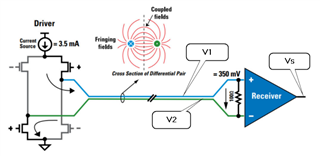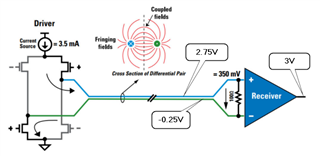Other Parts Discussed in Thread: TMUX646
- Does it also support LVDS with a common mode of 1.25v?
- Is it one or both direction for the clk lane?
This thread has been locked.
If you have a related question, please click the "Ask a related question" button in the top right corner. The newly created question will be automatically linked to this question.
Hello Lei,
The device does support LVDS. Regarding common mode it depends on the voltage on the differential lanes.
For example:
Let V1 be the voltage on lane 1 and V2 be the voltage on lane 2. Vs be the voltage of your end device and Vcm the common mode voltage.
Results in the following equations:
V1 = Vs/2 - Vcm -> V1 = Vs/2 - 1.25
V2 = Vcm - Vs/2 -> V2 = 1.25 - Vs/2
As long as you use the right voltage levels in your application, the device will support common mode of 1.25V.
Yes, all of our devices are bidirectional.
Thanks,
Nir
Hi Nir, thanks for your reply.
I don't receive notification, so be here late.
I am just a bit confused what you want to say about
V1 = Vs/2 - Vcm -> V1 = Vs/2 - 1.25
V2 = Vcm - Vs/2 -> V2 = 1.25 - Vs/2
Is there any requirement for VDD if I want to use it for higher cm voltage (LVDS)?
Thanks
The TS5MP645 has no specifications for I/O voltages above 1.3 V, not even typical values (see figures 1/2/3). I suspect that this device uses only N-channel pass transistors, i.e., the switches have much worse characteristics or do not work at all near the positive supply.
Hello Lei,
In the LVDS there are two communication lanes, one transmits and the other receives and they are both connected to some kind of a receiver.
Please see diagram below with V1, V2 and Vs highlighted:

In order to have a common mode of 1.25V. V1, V2, and Vs need to be at a specific voltage value. To find those values the following equations can be used:
V1 = Vs/2 + 1.25 (I noticed I put a "-" sign instead of "+", in my original reply, that was a mistake)
V2 = 1.25 - Vs/2
VDD doesn't affect the common mode voltage. The voltage difference on the two lanes and the voltage on the receiver affect it.
For example:
Let's say in the system, you set the voltage on the receiver (Vs) to be 3V, and since we are trying to have a common mode of 1.25V:
V1 = 3/2 + 1.25 = 2.75V
V2 = 1.25 - 3/2 = -0.25V
So we get the following system with a common mode of 1.25V:

Thanks,
Nir
Hi Nir,
Thanks for your reply. But I am afraid you are very wrong.
I can tell you V1 = 1.25 + 0.35/2; V2= 1.25 - 0.35/2
Could you find another colleague of yours and help with my questions?
The main question now is when V1 is more than 1.4V (higher than MIPI), is there any requirement for TS5MP645 VDD?
As mentioned, all the DC characteristic is measured below 1.3V? Can you guarantee the same performance when V1/V2 is higher?

Hi Lei,
I think Nir's equations are correct but the value he used for Vs was much higher than your application it seems, if you Vs is 0.35V, your equations are correct and the peak voltage is 1.425 V. That should be ok as long as the VDD > 1.425V.
You are correct that the conditions in the datasheet are only up to 1.2V, but the device will still function up to 3.6V on the I/O pins, according to the Recommended Operating Conditions.
What speed (GHz) are you planning on running your LVDS? The bandwidth of the TS5MP645 will degrade with the higher V1/V2 so I can't guarantee it, but if the device bandwidth is much higher than application it should be ok.
Finally I would actually recommend the TMUX646, it is higher voltage and a newer variant to the TS5MP645.
Thanks,
Stephen
Hi Stephen,
Thanks for help.
Never seen the swing voltage that high to achieve high bandwidth. Anyways.
The speed will be below 500 Mhz.
I hope you could give more clear conclusion as the supplier. We need know in what exact condition, you can guarantee the performance.
Nice to know TMUX646. I just see, TS5MP645 is not recommended for new design. We will definitely go with the new one.
BRs Lei
Hi Lei,
At 500 MHz, I feel confident that the TMUX646 should work for this use case. Again assuming the VDD is set high enough, at least 1.5V. I would recommend 3.3V for the best performance.
For the PCB design I recommend this application note to ensure you get the most performance out the TMUX646 and your LVDS signal.
https://www.ti.com/lit/an/scaa082a/scaa082a.pdf?ts=1706212978071&ref_url=https%253A%252F%252Fwww.google.com%252F
Thanks
Stephen